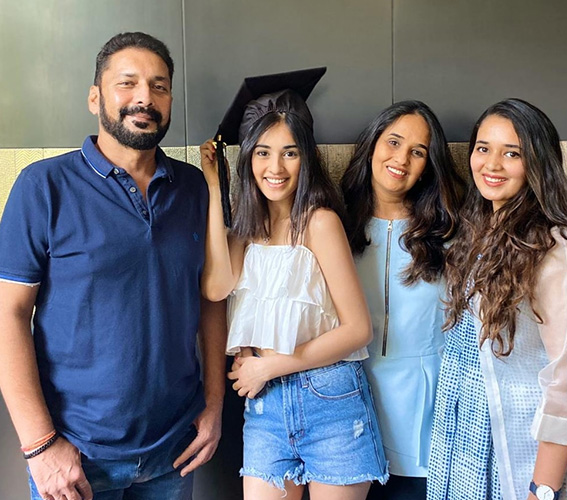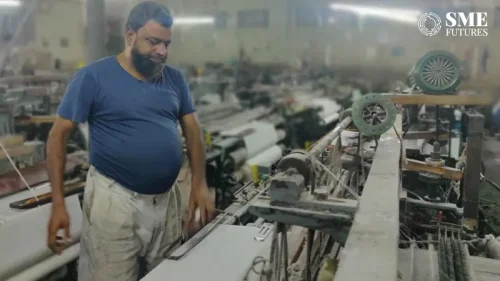Babita Jain is a self-taught textile designer and artist from Ahmedabad. As a mompreneur she is the founder of House of Prana, a lifestyle, fashion, artwork and home accessories brand.
She had it all, a beautiful home and a loving family along with fifteen years of garment work experience, but something was still missing—the passion she had for art had been put aside for a long time. But her daughter helped her to reignite this passion. After much hard work and using her creativity and expertise in the garment business, Jain brought everything together in her brand—House of Prana.
SME Futures, in a one-on-one conversation, celebrates Mother’s Day with Babita Jain and talks to her about her inspiring journey.
Edited Excerpts
Why do you think mothers make the best entrepreneurs?
Women take the role of a mother very seriously and great qualities like multi-tasking, the ability to do hard work, determination, working under pressure and calm and empathetic behaviour come naturally to them as they take on this role.
Being a mother and starting your own business or being an entrepreneur has more in common than one might think. This means that raising kids can actually do wonders in preparing one to run a successful business. Fact is that raising a family (especially an Indian family with multiple roles and responsibilities that an Indian mother is expected to shoulder) might be more similar to running a start-up than most people would realize.
Think about it, the skills that one acquires from parenthood and assimilates into a start-up, which is a tedious process, include patience and perseverance. Now, with multiple responsibilities on their plates, mothers often become the chief executives and chief operating officers of their families. They definitely are the best entrepreneurs as the have all the qualities that great entrepreneurs must have to start a new business and make it profitable.
How did motherhood push you to become an entrepreneur? Tell us about the evolution of House of Prana.
My art journey began in school where fine art was my favourite subject. I loved playing with colours on canvas, especially with the ombre effects. Born in a garment exporting family, I was always attracted towards fabrics and textures, so I joined the family business just after graduation. In 1996, my family life took over, but I continued to instil art into my children’s routines because I knew how important it was.
After my children grew up, I decided it was time that I should pursue something that I liked doing. I wholly owe my journey from an artist to an entrepreneur to my daughter Tanya as she was the one who made me realize my love for art and fabrics after a sabbatical of almost 20 years.
I started with making paintings first but was not satisfied as my true passion always lay in fabrics. So, I thought of using my creativity on fabrics. That is how the idea of designer, one of their kind, luxurious scarves was born. I finally launched House of Prana in 2018. My art’s inspiration comes from the soul, so I finalized the name Prana, i.e., breath, considered as the life-giving force.
I feel any business is best when it makes us content. Our final set goal should be motivating enough for us to start our day with zest. Hard work, determination and perseverance are the key factors which enabled me to start my entrepreneurial journey. For me, House of Prana is a platform to elevate my team members and showcase my skills, creativity, insight and foresight.
With many years of experience in the garment business, I have an eye for commercial fashion and detail in product styling. I am a quick learner and wanted to use my creative skills and profound understanding of textile and different colour concepts and their application in design making. All the art designs in my collection have been exclusively created by me and are used as digital prints. I gradually started to create different lifestyle and home decor products like scarves, cushions, table mats and trays and experimented with a few clothes as well.

Have you ever got inspired by your children and then assimilated that into your work? Tell us about an instance of this.
Both my children had heard about my creative skills and love for art from my paternal family and as they grew up, they urged me to use my hard work and talent for something more productive.
With my domestic help taking good care of us and after my children grew up and finished high school, I joined the Women Organisation FICCI Flo, Ahmedabad chapter. I enjoyed being a part of FLO as it gave me plenty of opportunities to network with like-minded women who were entrepreneurs as well. Being with them I always got inspired to start something of my own but could not realise my calling.
In 2018, my daughter asked me to tell her the one thing that I liked to do most when I was in school. I told her that I loved painting but had to let go of that passion as I had responsibilities to fulfil – from attending college to joining my father’s garment business, I had to do it all.
She immediately gave me a canvas and some paints and told me to show her my skills. From then on, every day she kept forcing me to paint, until the day I realised that I could convert my artwork into exclusive digital prints to make gorgeous products out of it. She also helped me to brainstorm a brand name – Prana, designed the logo and website for me and guided me to delve into some research on my competitors so that I could be well versed with the current market scenario.
I am truly grateful to her for my entire entrepreneurial journey.
Being a mom and a boss, tell us about the life hacks you employ in the WFH scenario. How are you balancing all at the same time?
I am truly blessed and grateful as my husband has always supported me. He provided me with an office space on the same premises as his which is just a mile away from my house. In fact, this became super easy for me as I leave for the office with him after assigning duties to my house staff.
It also keeps me calm as I know my husband and I are together working in the same building in different cabins. My children (who are also working in the same building), since they are young, help me with any technical issues that arise.
Moreover, I have been able to use most of the life hacks that I have learnt while bringing up my children, in my work from home office. When my children were growing up, they taught me that anything is possible –you just need to work hard and believe in yourself.
When things got chaotic or went wrong, spending time with my children taught me to break the problem down into bite size pieces and forge ahead, taking on each piece one at a time until the issue was resolved. This has worked wonders in the work from home scenario as now no problem is so big that it is unsolvable. I have been empowered by this belief throughout my motherhood, something that fuels me now more than ever as an entrepreneur. My life is truly beautiful, productive and creative.
Entrepreneurship is in trend now. Was the journey a difficult or an easy one? What were the challenges faced and lessons learnt during this phase?
House of Prana is an emerging company, and we did face a few challenges.
Initially, I started with physical exhibitions and worked on a consignment basis with a few stores in Ahmedabad, Nagpur, Kanpur, Goa etc. apart from our website presence. But due to tough competition and cheaper substitutes of abstract art scarves, the sales were low. I slowly started to list my products on a few online portals like Nykaa fashion and Natty. I did get a decent response, but it was really not that overwhelming.
Before I could garner proper results, the pandemic hit us all. The top challenge was people management during the pandemic. There were low sales because of no exhibitions in physical spaces due to social distancing norms during the pandemic. There was also low consumer demand as people have become very conscious of their needs.
Additionally, we are a small team, but a few people left their jobs for better prospects, closer to their family, hometown etc. In this trying time, I decided to hire freelancers instead of permanent employees to reduce costs. This also enabled new teams to bring in new and fresh ideas, so it was a win-win situation for me. When companies give promotions or invest in their teams’ professional development, they typically do not consider the freelancers. But this pandemic shifted my mind set. I now truly believe that interacting and working with the new generation does help in bringing great and fresh ideas to the table.
Women have a harder time securing venture capital than men do, what was your experience as a mompreneur?
In the past few years, we have seen multiple Indian women entrepreneurs emerge from both metro and tier II and III cities and all this success is truly wonderful. However, there exists an underlying issue that is keeping women from being even more impactful–difficulty in finding adequate funding like the men in the same industry can source.
Access to capital funding is truly crucial to any small business’s growth. But there are multiple reasons as to why women entrepreneurs have a harder time obtaining investments or loans – it could range from biases or preconceptions like the fact that they might believe that women cannot handle both; their homes and their businesses, which I think is an utter misconception.
I was lucky though as my brand is an emerging brand, and I did not need the help of venture capitalist and also, the initial finance to launch my brand was provided by my husband.
Despite the progress women have made in Indian society, do you think we are still battling with subtle stereotypes in India, especially when women become homepreneurs? What needs to change?
Women should be the one who get to decide their priorities and work life balance and men should not be given the opportunity to judge them on this aspect. Their work should be given equal priority and value as any man’s work is given. In fact, women should be respected for playing their dual roles of homepreneur/mompreneur and entrepreneur so well.
What would you like to say to the mompreneurs who are just at the beginning of their journey and experiencing some doubts?
Starting a business is a very personal journey. You are probably a creative person, with something different to offer in a fast-moving industry. It is likely that you have spotted a gap in the market or have a unique design in mind for a specific customer group. But bear in mind that the fashion industry, specifically, is notoriously difficult to predict. There is no space for being impulsive and hence your plan will need to be flexible as there are no guarantees. One will always have to be up for multiple challenges and deal with them as and when they pop up.
What are your plans going ahead, and the roadmap for House of Prana? What exciting things are you working on currently?
I believe that India is undergoing a transformation; there is a hybridisation of Indian culture. Indians are striving to find a balance between their cultural traditions and the changes which are the result of a global economy. And it seems Indians are adapting well to the cultural hybridisation model in response to globalisation with a balanced mix of tradition and modernity. Keeping this in mind, I launched House of Prana, a label with international sensibilities and Indian roots, which at the same time is contemporary and modern as well.
My brand was created to stimulate a conversation about aesthetics, well-being and optimal living, with its customers. I believe in providing Indian comfort with a touch of modern luxury and style in one wrap. Textiles such as Pure Silk, Peace Silk (Ahimsa silk), Georgette and Pashmina in our library speak the language of lustrousness. Our scarves are made for the people of today who have their roots in yesterday. Using Peace silk as a luxury brand, our commitment is to respect the invisible connections and life forms that create our sustainable range of scarves.
Meanwhile, the pandemic has brought a lot of changes in customer psychology. They have started believing in the mantra ‘Less is more.’ All of them have become sustainable and want to buy only things which are necessary. It is good for a brand which aims to elevate sensibilities as it embodies the qualities of living more with less. Through Prana’s accessories, women can dress up and dress down based on the occasion without falling prey to over consumption.
House of Prana is my dream, and I am working hard to make it a very successful project. Though times are tough, I have kept away from low expectations and instead concentrated on increasing visibility through social media and the print media.
Moreover, great ideas remain beautiful hypotheticals if there isn’t a way to implement them. I personally think of an idea as an inspiration, and the organisation of that idea is the work required to actualize it. But that work isn’t a one-time activity, of course: it is a process that flows from one task to the next. There are many points along that journey, from the idea to the execution to the customer. I have applied these rules in building House of Prana as a brand and to all its products as well.
Five years from now, I would like to see House of Prana as a flourishing, highly successful and globally renowned brand. I would also like to diversify into clothing in the near future.











